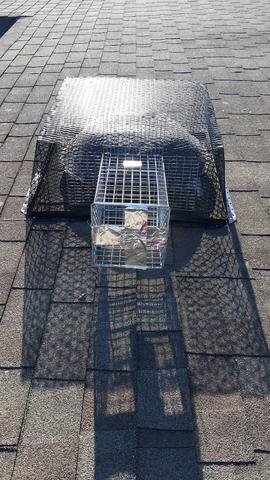Met by surly mama Raccoon in Seaside Park attic
Challenge
A residential customer of Cowleys in Seaside Park contacted us about a continuing problem from last year — raccoons in her attic. Raccoons, which can weigh up to twenty pounds, are one of the largest animals that our nuisance wildlife technicians commonly encounter. Raccoons are also one of the nastiest. Don’t be fooled by their “cute” bandit coloration. These animals, with their razor-sharp teeth and claws, can be vicious. Once inside a home, they can cause significant property damage, and they also pose significant health risks to a home’s occupants. Raccoon urine and droppings, whose spores can become airborne, carry many dangerous pathogens. In New Jersey, raccoons are the primary carriers of rabies.
During nesting season, which peaks in March and runs through late winter and early spring, raccoons look for a safe nesting area away from predators and the harsh outdoor elements. Unfortunately, these critters look at our attics as prime nesting locations. The mother scouts around her territory looking for a good birthing spot. She can easily tear open holes in roofs, soffits, or fascia, especially if the building materials are already weakened from water damage. If you have a raccoon problem in your attic, there is a good chance that the intruder is an expectant female, but a particularly bad winter can also drive male raccoons inside your home. Whenever I am dealing with a raccoon problem in an attic, I assume the worst — that I am dealing with a female raccoon with babies. While all raccoons, as pretty much all wildlife, can become vicious when cornered, there is nothing quite like a highly aggressive mother protecting its babies. To say that it’s best to not cross paths with a protective raccoon mom is a huge understatement.
Solution
When I arrived on the scene, I immediately met with the homeowner to listen to the whole situation and get as much background information as I could. She was pretty frazzled considering that she just dealt with a raccoon infestation last year. The last thing any homeowner needs is an annual raccoon family reunion. I was determined to resolve this problem quickly, and hopefully, permanently.
I cautiously entered the attic. If you want to get your adrenaline going all you need to do is climb up an attic ladder knowing that a surly female raccoon may be waiting for you at the top, and she will be none too pleased that you are in the vicinity of her babies. As I entered the attic, I found myself to be a short distance between me and a raccoon. Knowing that there was an active raccoon infestation in the attic was more than enough information. I slowly backed out of the attic so as to not alarm the raccoon. Next, I inspect the entire exterior to find the raccoon entry point. Usually, because of the size of these animals, it doesn’t take much effort to find the hole used to gain access inside the home. Here, as often happens, the attic fan on the roof was ripped open. The strength of these animals never ceases to amaze me. I installed two safe humane box traps. Once caught, I’ll relocate the animal far away from human habitats. I also installed a one-way device over the hole. This will allow the animal to leave, but it’s a one-way trip. It will not allow the animal back inside. After trapping is completed, I’ll re-enter the attic to make sure that there are no babies still up there. If there are babies, we will remove them and find them a safe new home.
There was quite a bit of damage to the attic insulation. I explained that Cowleys installs TAP insulation, our blown-in pest control cellulose insulation, as well as our cleaning and sanitation services to remove any hazardous droppings and neutralize any pheromone scents, which will help prevent future animal issues. The homeowner was completely on board to do what it will take get her attic safe and clean. I’m confident that with a thorough cleaning and sanitizing and by installing a protective cover over the attic fan once the roof damage is repaired, this raccoon nightmare will not happen again.


